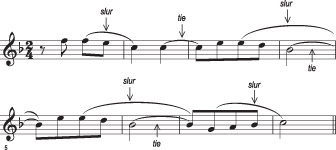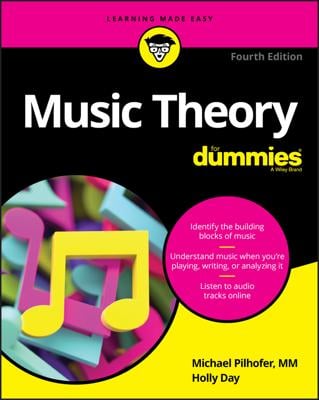Dynamic markings tell you how loudly or softly to play a piece of music. In music theory, composers use dynamics to communicate how they want a piece of music to “feel” to an audience, whether it’s quiet, loud, or aggressive, for example.
Check out the most common dynamic markings, from softest to loudest.
| Notation | Abbreviation | Description |
|---|---|---|
| Pianissimo | pp | Play very softly |
| Piano | p | Play softly |
| Mezzo piano | mp | Play moderately softly |
| Mezzo forte | mf | Play moderately loudly |
| Forte | f | Play loudly |
| Fortissimo | ff | Play very loudly |
Dynamic markings can be placed at the beginning or anywhere else within a piece of music. For example, pianissimo (pp) means that the piece is to be played very softly until you reach the next dynamic marking. Fortissimo (ff) means that the rest of the selection is to be played very loudly.

Modifying phrases
Sometimes when reading a piece of music, you may find one of these markings attached to a musical phrase or a section of music generally four to eight measures long.
| Notation | Abbreviation | Description |
|---|---|---|
| Crescendo | cresc. | Play gradually louder |
| Diminuendo | dim. | Play gradually softer |
The long cresc., called a hairpin, means to play the selection gradually louder and louder until you reach the end of the crescendo.

The hairpin beneath the phrase means to play the selection gradually softer and softer until you reach the end of the diminuendo.

Another common marking you’ll probably come across in written music is a slur. Just like when your speech is slurred and the words stick together, a musical slur is to be played with all the notes “slurring” into one another. Slurs look like curves that connect the notes.

Checking out other dynamic markings
You probably won’t see any of the following notations in a beginning‐to‐intermediate piece of music, but for more advanced pieces, you may find one or two:
Agitato: Excitedly, agitated
Animato: With spirit
Appassionato: Impassioned
Con forza: Forcefully, with strength
Dolce: Sweetly
Dolente: Sadly, with great sorrow
Grandioso: Grandly
Legato: Smoothly, with the notes flowing from one to the next
Sotto voce: Barely audible
Examining the piano pedal dynamics
Additional dynamic markings relate to the use of the three foot pedals located at the base of the piano (some pianos have only two pedals). The standard modern piano pedal setup is, from left to right:
Soft pedal (or una corda pedal): On most modern upright pianos, the soft pedal moves the resting hammers inside the piano closer to their corresponding strings. Because the hammers have less distance to travel to reach the string, the speed at which they hit the strings is reduced, and the volume of the resulting notes is therefore much quieter and has less sustain.
Most modern grand pianos have three strings per note, so when you press a key, the hammer strikes all three simultaneously. The soft pedal is called una corda (“one string”) because it moves all the hammers to the right so that they only strike one of the strings. This effectively cuts the volume of the sound by two‐thirds.
Middle pedal: If it’s present (many modern pianos have only the two outer pedals to work with), the middle pedal has a variety of roles, depending on the piano. On some American pianos, this pedal gives the notes a tinny, honky‐tonk piano sound when depressed. Some other pianos have a bass sustain pedal as their middle pedal.
It works like a sustain pedal but only for the bass half of the piano keyboard. Still other pianos — specifically many concert pianos — have a sostenuto pedal for their middle pedal, which works to sustain one or more notes indefinitely, while allowing successive notes to be played without sustain.
Damper pedal (or sustaining or loud pedal): The damper pedal does exactly the opposite of what the name would imply — when this pedal is pressed, the damper inside the piano lifts off the strings and allows the notes being played to die out naturally. This creates a ringing, echoey effect for single notes and chords (which can be heard, for example, at the very end of The Beatles’s “A Day in the Life”). The damper pedal can also make for a really muddled sound if too much of a musical phrase is played with the pedal held down.
In sheet music notation, the entire musical phrase to be altered by use of pedals is horizontally bracketed, with the name of the pedal to be used listed beside or beneath it. If no pedal number is given, the damper pedal is to be automatically used for the selection.
For example, the “Ped.” signifies that the damper pedal (usually the foot pedal farthest to your right) is to be depressed during the selection. The breaks in the brackets (shown with ^) mean that in these places, you briefly lift your foot off the pedal.
Looking at the articulation markings for other instruments
Although most articulation markings are considered universal instructions — that is, applicable to all instruments — some are aimed specifically at certain musical instruments. Check out some of these markings and their respective instruments.
| Notation | What It Means |
|---|---|
| Stringed instruments | |
| Martellato | A short, hammered stroke played with very short bow strokes |
| Pizzicato | To pluck the string or strings with your fingers |
| Spiccato | With a light, bouncing motion of the bow |
| Tremolo | Quickly playing the same sequence of notes on a stringed instrument |
| Vibrato | Slight change of pitch on the same note, producing a vibrating, trembling sound |
| Horns | |
| Chiuso | With the horn bell stopped up (to produce a flatter, muted effect) |
| Vocals | |
| A capella | Without any musical accompaniment |
| Choro | The chorus of the song |
| Parlando or parlante | Singing in a speaking, oratory style |
| Tessitura | The average range used in a piece of vocal music |

